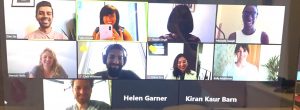#UnleashInclusion – Race Matters by Dee Jas, colourfull
For a sunny Thursday morning, talking about race and racism may have felt heavy. But we were lucky enough to have an open hearted group of leaders who were willing to share and talk honestly about the nuances of race and ethnicity and their impact in the workplace.
Beyond defining what race and ethnicity are (they are distinct yet interrelated), a crucial point in the session was acknowledging race is a social construct – much in the way of gender. The overriding theme through the session was to appreciate that issues of race aren’t limited to the workplace, and it impacts wider society. So, it follows that to have productive conversations about race, we need to take a wider view of the world we live in and connect that back to what’s happening in our organisations.
Racial groups were created in the 18th century by anthropologists and philosophers, using geographical location and visible traits such as skin colour to underpin these groupings. It became widely accepted that some ‘races’ were superior to others and that biological differences were the foundation of different races.
Cut to today and this notion has been debunked. Humans share over 99% of genetic material with one another and the greatest variations actually occur within racial groups rather than between groups i.e. it’s more likely that there are more differences at a genetic level between two Koreans than a Korean and Italian.
So, if race is ‘man-made’, it should be easy to dismantle? The answer is NO. Unfortunately, the racial hierarchy that has been created (White at the top, Black at the bottom and everything else in between) is present in society and in the workplace (Kandola 2018). Beyond individual acts of bad behaviour (aka interpersonal racism), our systems and structures are designed to reproduce this racial inequality (known as institutional racism). In practice, this can be a lack of workforce diversity or that BAME employees are 4 times more likely to receive a poor performance rating (CIPD, 2018).
To break down race and racism, we need to look at the impact of our workplace practices on BAME/People of Colour (POC), and redesign how we work. This has to be relevant to your business and done in partnership with your people – the biggest danger is the ‘copycat’ approach by applying techniques that work for other businesses into your own without the necessary translation.
This ties nicely to the next section, where we explored what makes conversation about race so tricky. There are various factors – the most obvious one being that we all know it tends to be a problem, but solving it is hard so it’s easier to ignore it. We also looked at the language used to describe the community of colour – and whether it was helpful or not? There is no universal term that makes everyone happy, be that BAME, POC or ethnic minorities – so the key is to find the term most useful to your business by engaging with those who are part of that community. And once you reach a term that makes sense, help those communities understand why you’ve chosen it, and how you intend to use it.
The biggest takeaway for me was that to have really great conversations about race, we had to have a wider frame of reference and a better understanding of the lived experiences of POC. This will lead to conversations that are more authentic, empathetic and likely to ease the discomfort people feel talking about race.
We’re excited for the next session where we’ll explore power and privilege.
Signing off for now, enjoy the bank holiday weekend!
Dee
